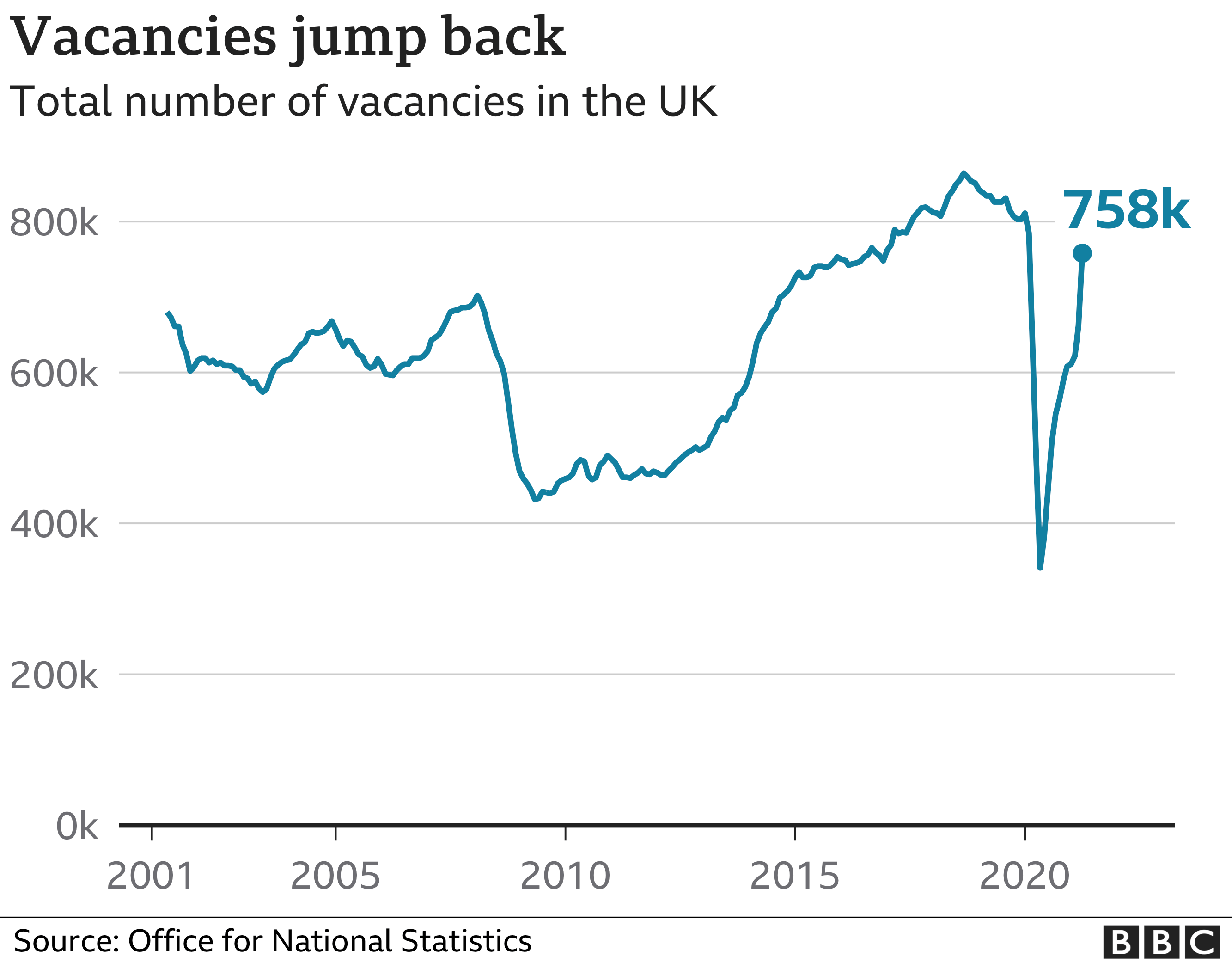
The jobs market is “showing signs of recovery”, official figures suggest, with the unemployment rate falling and the number of job vacancies rising.
Unemployment stood at 4.7% in the three months to April, down from 4.8% previously, the Office for National Statistics (ONS) said.
The number of job vacancies in March to May was 758,000 – just 27,000 below pre-pandemic levels.
However, unemployment among the young and those in hospitality remains high.
Sam Beckett, ONS head of economic statistics, said: “The number of employees on payroll grew strongly in May, up by almost 200,000, although it is still over half a million down since the pandemic struck.

“Job vacancies continued to recover in the spring, and our early estimates suggest that by May the total had surpassed its pre-pandemic level, with strong growth in sectors such as hospitality.
“Meanwhile the redundancy rate remains subdued, while the number of employees on furlough has continued to decline.”
What’s going on?
Unemployment rose sharply last year as the UK went through successive lockdowns, but it has gradually fallen in 2021 as restrictions are eased.
Firms appear to be expanding again, with the number of job vacancies in most industries above pre-pandemic levels in May, according to the ONS.
Similarly, the redundancy rate is back to levels seen before the spread of coronavirus.
However, the number of workers on company payrolls in the accommodation and food services sector, aged under 25, or living in London remains “well below” pre-pandemic levels, the ONS said.

How has furlough helped?
Paul Dales, chief UK economist at Capital Economics, told the BBC’s Today programme that the figures showed the labour market was “starting to turn in a good way after quite a painful year”.
“It is pretty much all down to the furlough scheme,” he said.
“That has been a huge success and quite frankly one of the best government policies I think that the modern economy has ever seen. Without that I do think we would have had unemployment rates of 8-9%, similar to the peaks we saw during the global financial crisis.”
Mr Dales noted there were still 3.4 million people on furlough but said the “way the wind is blowing” meant many would end up returning to their jobs. If they did not, he said it “wouldn’t be too long until they found another one”.
Will the delay to unlocking spoil things?
There are fears the four-week delay to fully unlocking Covid restrictions will harm many firms, and the government has said it will not extend the furlough scheme (due to end in September) or other financial support. Hospitality, wedding and night-time entertainment businesses have all reacted with dismay.
However, Yael Selfin, chief economist at KPMG, said she expected the labour market to improve despite the delay, and that employers may struggle to fill gaps.
“Sharp declines in furloughed employees in those sectors that reopened on 12 April… coupled with anecdotal evidence of significant difficulties to fill vacancies in some sectors, point at increasing challenges to add staff in the coming months.”
What do politicians say?
Chancellor Rishi Sunak said: “Our Plan for Jobs is working – the latest forecasts for unemployment are around half of what was previously feared and the number of employees on payroll is at its highest level since April last year.”
But Labour’s shadow chancellor, Rachel Reeves, said the government needed to do more for businesses affected by the delay to removing restrictions.
“Many businesses have financial pinch points coming up but are still struggling to turn a profit.
“If businesses have to stay closed or operate at massively reduced capacity they’re not going to be able to pay staff, rents and loans back. Government support must recognise that.”

London hit hardest

There are a number of upbeat indicators in today’s jobs figures. Granted the latest estimate of the number on employers’ payrolls remains over half a million below its pre-pandemic level. The living standards think-tank the Resolution Foundation also estimates there are still 2.8 million people who remain on furlough and self-employed income support schemes who need to find work as support is withdrawn.
But that’s down from 6.2 million in March. And the number of job vacancies, at 758,000, is now back up to pre-pandemic levels. What’s unlike any other economic crisis of the past 50 years is that in this one, it’s London that’s been hardest hit by unemployment.
With financial sector employees continuing to work from home in large numbers, there’s less demand for the restaurants, coffee shops and shops that cater for the City of London’s much-reduced army of commuters. London alone still has fewer employees than it did in May last year and it now has the highest unemployment rate, at 6.5%, of any region.

